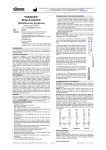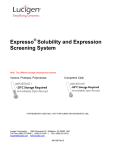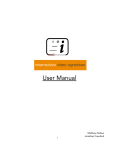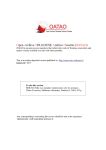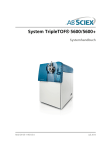Download Instruction for use Mode d`emploi Gebrauchsanweisung
Transcript
Ebola Rapid lateral flow test Test rapide Schnelltest Rapid lateral flow test for the qualitative detection of Ebola virus antigen VP 40 in serum and throat swab. For Professional In Vitro Diagnostic Use Only Kit de détection rapide de l‘antigène VP 40 du virus Ebola dans le sérum humain et sur frottis pharyngé. Réservé à un usage exclusivement professionnel de diagnostic in vitro Schnelltest zum qualitativen Nachweis von EbolaVirus Antigen VP 40 im Serum und Rachenabstrich. Nur für die professionelle In-vitro-Diagnostik GB Instruction for use F Mode d‘emploi D Gebrauchsanweisung GB Instruction for use Stada Diagnostik Ebola Rapid lateral flow test Rapid lateral flow test for the qualitative detection of Ebola virus antigen VP 40 in serum and throat swab For Professional In Vitro Diagnostic Use Only REF 2.13.1.122 Intended use Stada Diagnostik Ebola Rapid lateral flow test is a rapid visually read chromatographic immunoassay for the qualitative detection of Ebola virus antigen in human serum and throat swab. To serve as a procedural control, a colored line will always appear in the control line region indicating that reaction conditions and technology worked fine (proper volume of specimen has been added and membrane wicking has occurred). Kit components/Content of the kit Kit for 20 determinations 20 test cassettes in aluminium pouch including desiccant bag It is intended to be used as an aid to detect Ebola hemorrhagic fever in case of infectious diseases with fever. It is intended to be used only together with clinical information/ methods and other in vitro diagnostic procedures. Summary 20 transfer pipettes Ebola hemorrhagic fever (Ebola HF) is a severe, often fatal disease in humans and nonhuman primates (monkeys, gorillas and chimpanzees) that has appeared sporadically. The virus is one of two members of a family of RNA viruses called the Filoviridae. There are four identified subtypes of Ebola virus. 90 % of the outbreaks are caused by Ebola Zaire. 20 sterile polyester tipped applicators/swabs Principle Stada Diagnostik Ebola Rapid lateral flow test is a qualitative, rapid, membrane-based immunoassay for the detection of Ebola virus antigen VP 40 in human serum and throat swab. After applying the sample to the sample well it can react with particles coated with anti-Ebola antibodies. The mixture migrates upward on the membrane by capillary action. By reaching the test line region antigen bound to the particles can react with the capture reagent anti-Ebola antibody immobilized on the test line of the membrane and generate a colored line. 2 The presence of a colored line in the test region indicates a positive result (presence of Ebola antigen), while its absence indicates a negative result. The test contains antiEbola antibody-coated particles, anti-Ebola antibodies and anti-mouse IgG immobilized on nitrocellulose membrane. Do not freeze. Warnings and precautions The test cassette is sensitive to light or humidity, therefore do not use test devices that have become wet or if the pouch is damaged or shows signs of damage! Handle all specimens and used test components as though they contain infectious agents. Observe established precautions against microbiological hazards throughout the procedure. Appropriate biosafety practices must be used when handling specimens and test components. These precautions include, but are not limited to the following. After opening of the test cassette pouch the test has to be performed immediately, at least within 1 hour. After opening, the buffer vial can be stored at +4° C to +30° C (+39° F to +86° F) for at least 3 months. Specimen Specimen should be collected, handled and shipped using appropriate infection control precautions for Ebola, other hemorrhagic fever viruses or other infectious diseases. Shipping may be performed according to the policies of the shipping performer, customs reg ulations, and the requirements of the receiving laboratory. If specimens are to be shipped, they should be packed in compliance with federal regulations for transportation of etiologic agents. 20 extraction tubes Serum 1 work station for up to 8 extraction tubes 1 extraction buffer 10 ml, ready-to-use Only use human serum collected and prepared according to the manufacturer’s instructions for the specimen collection device. Only clear, non-hemolyzed specimens may be used. The buffer solution contains detergent and preservative. 1 package insert Equipment required but not provided Serum may be stored at +2° C to +8° C (+35° F to +46°F) for up to 3 days. For long-term storage, specimens may be kept below -20° C/-4° F. Timer, for measuring the time between application of the specimen and interpretation of the results after ten minutes. Bring specimens to room temperature prior to testing. Frozen specimens must be completely thawed and mixed well prior to testing. Specimen collection device. Specimens should not be frozen and thawed repeatedly. Storage and stability Store Stada Diagnostik Ebola Rapid lateral flow test unopened at +4° C to +30° C (+39° F to +86° F) and use by the date given on the label. Do not use any component past the labeled expiration date. Throat swab Use specimen at room temperature only (+15° C to +30° C/+59° F to +86° F). Only use fresh throat swab. Do not store. Do not freeze. • Wear personal protective equipment: powder-free gloves, lab coat, eye protectors etc. • Do not eat, drink, smoke, apply cosmetics, or handle contact lenses in areas where these materials are handled. • Clean and disinfect all spills of specimens using suitable disinfectant, such as 0.5% sodium hypochlorite, or other suitable disinfectant. • Decontaminate and dispose all specimens, test components and other potentially contaminated materials in accordance with local regulations. Testing procedure STADA Diagnostik Ebola xxxxxxxxxx Fig. 1: test cassette Preparation Allow test components and specimen to equilibrate to room temperature (+15° C to +30° C /+59° F to +86° F) prior to testing. • Remove the test cassette from the sealed pouch and use it as soon as possible. The test should be performed within 1 hour after opening the pouch. 3 GB Instruction for use • Place the test cassette on a clean and level surface. • Clearly indicate the patient/specimen identification on the test device to avoid confusions. • Place the extraction tube in the work station and indicate the patient/specimen identification on the tube. Throat swab • Hold the extraction buffer bottle vertically and add 8 to 10 drops of the extraction buffer solution to the extraction tube. Only use the buffer solution provided with this test kit. • Insert the provided sterile swab into oral cavity. • Very gently push the swab until resistance is met at level of the pharynx. • Gently rotate the swab for a few times over the mucous membrane. • Immediately insert the swab with collected throat swab specimen, compress the bottom of the tube and rotate the swab vigorously to mix the reagents for at least 1 minute. Press the swab against the inside of the tube, and expunge as much liquid as possible from the swab by pressing and rotating the fiber portion against the wall of the tube. Discard the swab. • Let the mixture incubate for 1 to 15 minutes. • Mix the contents of the tube again by gentle swirling. • Now the mixture is ready to be tested. Fill the provided pipette with the mixture. • Hold the pipette above the sample well of the test cassette and squeeze 6 drops into the well. Wait until each drop is absorbed, before adding additional drops. • Start the timer. • Wait 10 minutes from addition of the specimen/buffer mixture and then read the results. Do not interpret the results after more than 15 minutes. 4 Serum • Hold the extraction buffer bottle vertically and add 3 drops (approx. 100 µl) of the extraction buffer to the extraction tube. Only use the buffer included in the test kit. • Hold the provided transfer pipette vertically, transfer 3 drops of specimen (approx. 100 µl) into the extraction tube and incubate for 1 to 15 minutes. • Now the mixture is ready to be tested. Fill the provided transfer pipette with the mixture, hold the pipette vertically above the sample well of the test cassette and drop the whole mixture into the sample well. Wait until each drop is absorbed, before adding additional drops. • Start the timer. • Wait 10 minutes from addition of the specimen/buffer mixture and then read the results. Do not interpret the results after more than 15 minutes. STADA Diagnostik Ebola STADA Diagnostik Ebola xxxxxxxxxx xxxxxxxxxx control line region test line region If the control line fails to appear (insufficient specimen volume or incorrect procedural techniques are the most likely reasons), the test result is INVALID (figure 4). Review the procedure and repeat the test with a new test cassette. If the problem persists, discontinue using the test kit immediately and contact your local distributor. Interpretation of results Fig. 4: schematic illustration of invalid results NEGATIVE: one colored line appears in the control region (C). No apparent line appears in the test region (T) (figure 3). Limitations STADA Diagnostik Ebola xxxxxxxxxx control line region test line region Fig. 3: schematic illustration of a negative result INVALID: control line fails to appear (figure 4). If there is no colored line in the control region (C), even if a colored line appears in the test region (T), the result is invalid and the test should be repeated with a new test cassette. STADA Diagnostik Ebola xxxxxxxxxx Stada Diagnostik Ebola Rapid lateral flow test is designed for in vitro qualitative detection of Ebola antigen VP 40 in human serum and t hroat swab. Other body fluids and pooled s pecimens may not give accurate results, and should not be used. Stada Diagnostik Ebola Rapid lateral flow test should only be used in samples from patients with suspected Ebola infections (diseases with fever) as an aid to detect Ebola hemorrhagic fever. It should not be used as the sole criteria for the diagnosis of Ebola infection. Stada Diagnostik Ebola Rapid lateral flow test will indicate the presence of Ebola antigen concentrations ≥106 PFU/ml in the specimen. Therefore it should not be used to exclude e bola infections. Results should be interpreted by a physician only. Results should be used only together with clinical information/symptoms/methods and other in vitro diagnostic procedures (e.g. PCR techniques). The intensity of the colored line in the test region does not correlate to the titer of antigen in the specimen. POSITIVE: two distinct colored lines appear. One line should be in the control region (C) and another line should be in the test region (T) (figure 2). Any visible colored line in the test region should be interpreted as positive, even if the line in the test region appears lighter or darker than the line in the control region. test line region Fig. 2: schematic illustration of a positive result Quality control A procedural control is included in the test. A colored line appearing in the control region (C) is the internal procedural control. It confirms sufficient specimen volume and correct procedural technique. control line region A negative result at any time does not exclude the possibility of Ebola infection. control line region test line region 5 GB Instruction for use A positive result should be confirmed using another method and the result should be evaluated together with the overall clinical evaluation. False positive or false negative results may be produced by: • insufficient specimen volume or incorrect procedural techniques • using inappropriate specimen or materials (other buffer as contained in the test kit, other volumes of specimen and buffer as indicated) • disregard of the incubation time of 1 minute of specimen and extraction buffer • disregard of the waiting time of 10 minutes after applying the mixture to the test cassette Low titers of Ebola might result in a faint line appearing in the test region after a prolonged time. The “Hook effect” in case of very high levels of antigen in the specimen can lead to false negative results. At present, evaluation of Stada Diagnostik Ebola Rapid lateral flow test is still in progress. Further data currently is being collected. Performance characteristics The performance of the Stada Diagnostik Ebola Rapid lateral flow test has been compared with a WHO-certified PCR test using African patient samples in Conakry, Guinea. STADA Diagnostik Ebola Analytic sensitivity: ≤CT 23, Specificity: 98% References 1.Lucht A, Grunow R, Möller P, Feldmann H, Becker S: Development, characterization and use of monoclonal antibodies for the detection of Ebola virus. J Virol Methods 2003; 111:21-8 2.Grolla A, Lucht A, Dick D, Strong JE, Feldmann H: Laboratory diagnosis of Ebola and Marburg hemorrhagic fever. Bull Soc Pathol Exot 2005; 98:205-9 3.Becker S, Feldmann H, Will C, Slenczka W: Evidence of occurrence of filovirus antibodies in humans and imported monkeys: Do subclinical filovirus infections occur worldwide? Med Microbiol Immunol 1992; 181:43-55 4.World Health Organization. Outbreak(s) of Ebola haemorrhagic fever in the Republic of Congo, January-April 2003. Wkly Epidemiol Rec 2003; 78:285-9 5.Hartmann H Lübbers B, Cararetto M, Bautsch W, Klos A, Köhl J. Rapid quantification of C3a and C5a using a combination of chromatographic and immunoassay procedures. J Immunol Methods 1993; 166:35-44 6.Ksiazek TG, Rollin PE, Jahrling PB, Johnson E, Dalgard DW, Peters CJ: Enzyme immunosorbent assay for Ebola virus antigens in tissues of infected primates. J Clin Microbiol 1992; 30:947-50 7.National Committee for Clinical Standards Clinical Waste Management: Approved Guideline. NCCLS Document GPS-A. Villanova, PA: NCCLS 1993; 13:1-18, 29-42 8.Towner JS, Rollin PE, Bausch DG, Sanchez A, Crary SM, Vincent M, Lee WF, Spiropoulou CF, Ksiazek TG, Lukwiya M, Kaducu F, Downing R, Nichol ST: Rapid diagnosis of ebola hemorrhagic fever by reverse transcription-PCR in an outbreak setting and assessment of patient viral load as a predictor of outcome. J Virol 2004; 78:4330-41 Senova Gesellschaft für Biowissenschaft und Technik mbH Industriestraße 8, 99427 Weimar, Germany 6 Distributed by/Distribué par/Vertrieb durch: STADApharm GmbH, 61118 Bad Vilbel, www.stada.de 7 F Mode d‘emploi Stada Diagnostik Ebola Test rapide Kit de détection qualitative rapide de l‘antigène VP 40 du virus Ebola dans le sérum humain et sur frottis pharyngé La présence d’une bande colorée dans la zone de test indique un résultat positif (présence de l’antigène Ebola), alors que son absence indique un résultat négatif. Réservé à un usage exclusivement professionnel de diagnostic in vitro Pour contrôler la procédure, une bande colorée apparaîtra toujours dans la zone de la ligne de contrôle, indiquant que les conditions de la réaction et la technologie ont bien fonctionné (le volume d’échantillon correct a été ajouté et l’ascension capillaire a bien eu lieu au niveau de la membrane). REF 2.13.1.122 Utilisation visée Stada Diagnostik Ebola Test rapide est un test immuno-chromatographique à lecture visuelle rapide pour la détection qualitative de l’antigène du virus Ebola dans des échantillons de sérum humain ou prélevés par frottis pharyngé. Il est destiné à être utilisé dans le cadre de la détection de la fièvre hémorragique à virus Ebola, dans les cas de maladies infectieuses avec fièvre. Il ne peut être utilisé qu’avec les informations/méthodes cliniques et autres procédures de diagnostic in vitro. Résumé La fièvre hémorragique à virus Ebola (FHV) est une maladie grave et souvent mortelle pour l’homme et les primates (singes, gorilles et chimpanzés) qui se manifeste sporadiquement. Le virus est l’un des deux membres de la famille des virus à ARN appelés Filovirus. Quatre sous-types de virus Ebola ont été identifiés. 90 % des épidémies sont causées par la souche Ebola-Zaïre. Principe Stada Diagnostik Ebola Test rapide est un test immunologique qualitatif comportant une membrane pour la détection de l’antigène VP 40 du virus Ebola dans le sérum humain et sur frottis pharyngé. En appliquant l’échantillon sur le puits, celui-ci réagit avec des particules recouvertes d’anticorps anti-Ebola. Par action capillaire, le mélange migre vers le haut sur la membrane. En atteignant la zone de test, l’antigène lié aux particules peut réagir avec le réactif de capture, l’anticorps anti-Ebola, immobilisé sur la ligne de test de la membrane, et générer une bande colorée. 8 Composants du kit / Contenu du kit Kit pour 20 déterminations 20 tests de type cassette dans une poche en aluminium contenant un sachet de déshydratant. Le test contient des particules recouvertes d’anticorps anti-Ebola et d‘anti-IgG de souris immobilisés sur une membrane en nitrocellulose. 20 pipettes de transfert 20 cotons-tiges en polyester stérile 20 tubes d’extraction 1 station de travail avec jusqu’à 8 tubes d‘extraction 1 tampon d’extraction 10 ml, prêt à l’emploi La solution du tampon contient un détergent et un conservateur. 1 notice Matériel nécessaire mais non fourni Un minuteur, pour mesurer le temps entre l’application des échantillons et l’interprétation des résultats au bout de 10 minutes. Un appareil de collecte des échantillons. Stockage et stabilité Stocker Stada Diagnostik Ebola Test rapide non ouvert entre +4° C et +30° C (entre +39° F et +86° F) et l’utiliser avant la date indiquée sur l’étiquette. N‘utiliser aucun des composants après la date d’expiration figurant sur l’étiquette. Ne pas congeler. La cassette est sensible à la lumière et à l’humidité ; par conséquent, ne pas utiliser si une cassette est devenue humide ou si la poche est endommagée ou montre des signes de dégât ! Après ouverture de la poche de la cassette, le test doit être effectué immédiatement, au maximum dans l’heure qui suit. Après ouverture, le flacon de solution tampon peut être stocké entre +4° C et +30° C (entre +39° F et +86° F) pendant 3 mois minimum. Les échantillons Les échantillons doivent être prélevés, manipulés et expédiés en utilisant toutes les précautions de contrôle de l’infection par Ebola, d’autres virus de fièvre hémorragique ou d’autres maladies infectieuses. Une expédition est possible si elle est conforme aux recommandations de l‘expéditeur, aux réglementations douanières et aux exigences du laboratoire de destination. Si des échantillons doivent être expédiés, ils doivent être emballés conformément aux réglementations fédérales relatives au transport d’agents étiologiques. gelés et bien mélangés avant le test. Les échantillons ne doivent pas être recongelés après décongélation. Frottis pharyngés Utiliser uniquement des échantillons à température ambiante (+15° C à +30° C/+59° F à +86° F). N’utiliser que des cotons-tiges neufs. Ne pas stocker. Ne pas congeler. Mises en garde et précautions Manipuler tous les échantillons et les composants de tests utilisés comme s’ils contenaient des agents infectieux. Tout au long de la procédure, respecter les précautions nécessaires contre les risques microbiologiques. Lors de la manipulation des échantillons et des composants de tests, les pratiques de biosécurité doivent être respectées. Ces précautions comprennent entre autres : • Porter des équipements de protection individuelle : gants non poudrés, blouse de laboratoire, protections pour les yeux, etc. • Ne pas manger, boire, fumer, se maquiller ou mettre des lentilles de contact dans des zones où ces matières sont manipulées. Le sérum • Nettoyer et désinfecter tout renversement d‘échantillons en utilisant un désinfectant adéquat approprié, tel que de l’hypochlorite de sodium à 0,5 % ou un autre désinfectant approprié. N’utiliser que du sérum humain prélevé et préparé conformément aux instructions du fabricant relatives à l’appareil de collecte des échantillons. • Décontaminer et jeter tous les échantillons, composants de tests et autre matériel potentiellement contaminé, conformément aux réglementations locales. Seuls des échantillons clairs et non hémolysés peuvent être utilisés. Le sérum peut être stocké entre +2° C et +8° C (entre +35° F et +46° F) pendant 3 jours maximum. Pour un stockage de longue durée, les échantillons doivent être conservés en dessous de -20° C/-4° F. Ramener les échantillons à température ambiante avant d‘effectuer le test. Les échantillons congelés doivent être complètement décon9 F Mode d‘emploi Procédure les réactifs au moins 1 minute. Appuyer le coton-tige contre l’intérieur du tube et extraire autant de liquide que possible du coton-tige en appuyant et en tournant la partie fibreuse contre la paroi du tube. Jeter le coton-tige. STADA Diagnostik Ebola xxxxxxxxxx • Laisser le mélange incuber pendant 1 à 15 minutes. Fenêtres de résultats Puits d‘échantillons Fig. 1: cassette Préparation Laisser le temps aux composants de tests et aux échantillons de se stabiliser à la température ambiante (+15° C à +30° C/+59° F à +86° F) avant d‘effectuer le test. • Sortir la cassette de la poche scellée et l’utiliser dès que possible. Le test doit être effectué dans l’heure suivant l’ouverture de la poche. • Placer la cassette sur une surface propre et plane. • Indiquer clairement le nom du patient/de l‘échantillon sur la cassette afin d’éviter toute erreur. • Placer le tube d’extraction sur la station de travail et indiquer le nom du patient/de l‘échantillon sur le tube. Frottis pharyngé • Tenir verticalement le flacon du tampon d‘extraction et ajouter 8 à 10 gouttes de solution tampon dans le tube d’extraction. N’utiliser que la solution tampon fournie dans le kit de test. • Insérer le coton-tige stérile fourni dans la cavité buccale. • Pousser très doucement le coton-tige jusqu´à rencontrer une résistance au niveau du pharynx. • Tourner doucement plusieurs fois le coton-tige sur la muqueuse. • Insérer immédiatement le coton-tige avec le prélèvement d‘échantillon (dans le tube). Comprimer le fond du tube et faire tourner vigoureusement le coton-tige pour mélanger 10 • Mélanger le contenu du tube à nouveau en le tournant doucement. • Le mélange est maintenant prêt à être testé. Remplir la pipette fournie avec le mélange. • Tenir la pipette au-dessus du puits de la cassette et ajouter 6 gouttes dans le puits. Attendre que chaque goutte soit absorbée avant d’ajouter des gouttes supplémentaires. • Démarrer le minuteur. • Attendre 10 minutes à partir de l’ajout du mélange de l‘échantillon/la solution tampon, puis lire le résultat. Ne pas lire le résultat au-delà de 15 minutes. Le sérum • Tenir verticalement le flacon de tampon d‘extraction et ajouter 3 gouttes (environ 100 µl) de solution tampon dans le tube d’extraction. N’utiliser que la solution tampon fournie dans le kit de test. Contrôle qualité STADA Diagnostik Ebola Un contrôle de procédure est inclus dans le test. La bande colorée qui apparaît dans la zone de contrôle constitue le contrôle de procédure. Elle confirme que le volume d‘échantillon est suffisant et que la technique de procédure est correcte. Si la bande de contrôle n’apparaît pas (les raisons les plus probables sont un volume d‘échantillon insuffisant ou des techniques de procédure incorrectes), le résultat du test N‘EST PAS VALIDE (figure 4). Revoir la procédure et répéter le test avec une nouvellle cassette. Si le problème persiste, ne plus utiliser le kit de test et contacter le distributeur local. Interprétation du résultat POSITIF : deux bandes colorées distinctes apparaissent. Une bande doit se trouver dans la zone de contrôle (C) et l’autre dans la zone de test (T) (figure 2). Toute bande colorée visible dans la zone de test doit être interprétée comme étant un résultat positif, même si la bande dans la zone de test apparaît plus claire ou plus foncée que la bande dans la zone de contrôle. • Démarrer le minuteur. • Attendre 10 minutes à partir de l’ajout du mélange de l‘échantillon/de la solution tampon, puis lire le résultat. Ne pas lire le résultat au-delà de 15 minutes. zone de contrôle zone de test Fig. 3 : illustration schématique d‘un résultat négatif NON VALIDE : la bande de contrôle n’apparaît pas (figure 4). Si aucune bande colorée n’apparaît dans la zone de contrôle (C), même si une bande colorée apparaît dans la zone test (T), le résultat n‘est pas valide et le test doit être répété avec une nouvelle cassette. STADA Diagnostik Ebola xxxxxxxxxx STADA Diagnostik Ebola xxxxxxxxxx zone de contrôle • Tenir verticalement la pipette de transfert fournie, transférer 3 gouttes d’échantillon (environ 100 µl) dans le tube d’extraction et laisser incuber pendant 1 à 15 minutes. • Le mélange est maintenant prêt à être testé. Remplir la pipette de transfert fournie avec le mélange, tenir verticalement la pipette au-dessus du puits de la cassette et ajouter tout le mélange dans le puits. Attendre que chaque goutte soit absorbée avant d’ajouter des gouttes supplémentaires. xxxxxxxxxx zone de test STADA Diagnostik Ebola xxxxxxxxxx zone de contrôle zone de test Fig. 2: illustration schématique d‘un résultat positif NÉGATIF : une bande colorée apparaît dans la zone de contrôle (C). Aucune bande n’apparaît dans la zone de test (T) (figure 3). zone de contrôle zone de test Fig. 4 : illustration schématique de résultats non valides 11 F Mode d‘emploi Limites Stada Diagnostik Ebola Test rapide est conçu pour la détection qualitative in vitro de l’antigène VP 40 d’Ebola dans le sérum humain et dans le frottis pharyngé. Les autres liquides corporels et échantillons groupés peuvent ne pas donner de résultats exacts et ne doivent pas être utilisés. Stada Diagnostik Ebola Test rapide ne doit être utilisé que pour des échantillons de patients soupçonnés d’infection par Ebola (maladies avec fièvre) afin de permettre la détection de la fièvre hémorragique à virus Ebola. Il ne doit pas être utilisé en tant que seul critère pour le diagnostic de l’infection par Ebola. Stada Diagnostik Ebola Test rapide indique la présence de concentration de l‘antigène du virus Ebola ≥106 PFU/ml dans l‘échantillon. Aussi ne doit-il pas être utilisé pour exclure les infections par Ebola. L’interprétation des résultats ne doit être effectuée que par un médecin. minute pour l‘échantillon ou l‘extraction du tampon • le non-respect du temps d’attente de 10 minutes après avoir appliqué le mélange sur la cassette Après une durée prolongée, la faible concentration d’Ebola peut entraîner l’apparition d’une ligne très claire dans la zone de test. En cas de très hauts niveaux d’antigènes dans les échantillons, l’« effet crochet » peut conduire à des faux-négatifs. L’évaluation de Stada Diagnostik Ebola Test rapide est actuellement encore en cours. Nous collectons encore des données supplémentaires. Caractéristiques de performance La performance du Stada Diagnostik Ebola Test rapide a été comparée avec un test PCR certifié par l‘OMS en utilisant des échantillons de patients africains à Conakry, en Guinée. STADA Diagnostik Ebola Les résultats doivent être uniquement utilisés avec des informations / symptômes / méthodes cliniques et d’autres procédures de diagnostic in vitro (par ex. techniques utilisant la PCR). L’intensité de la bande colorée dans la zone test ne correspond pas au titre de l’antigène dans l‘échantillon. Sensibilité analytique: ≤CT 23 Spécificité : 98 % Un résultat négatif à un moment donné n’exclut pas la possibilité d’une infection par Ebola. Références Un résultat positif doit être confirmé en utilisant une autre méthode et le résultat doit être interprété avec l’évaluation clinique globale. Un résultat faux-positif ou faux-négatif peut être causé par: • un volume insuffisant d‘échantillons ou des techniques de procédure incorrectes • une mauvaise utilisation des échantillons ou de matières (autres que la solution tampon qui est contenue dans le kit de test, d’autres volumes d‘échantillons et de solution tampon que ceux indiqués) • le non-respect du temps d‘incubation d‘une 12 4.World Health Organization. Outbreak(s) of Ebola haemorrhagic fever in the Republic of Congo, January-April 2003. Wkly Epidemiol Rec 2003; 78:285-9 5.Hartmann H Lübbers B, Cararetto M, Bautsch W, Klos A, Köhl J. Rapid quantification of C3a and C5a using a combination of chromatographic and immunoassay procedures. J Immunol Methods 1993; 166:35-44 6.Ksiazek TG, Rollin PE, Jahrling PB, Johnson E, Dalgard DW, Peters CJ: Enzyme immunosorbent assay for Ebola virus antigens in tissues of infected primates. J Clin Microbiol 1992; 30:947-50 7.National Committee for Clinical Standards Clinical Waste Management: Approved Guideline. NCCLS Document GPS-A. Villanova, PA: NCCLS 1993; 13:1-18, 29-42 8.Towner JS, Rollin PE, Bausch DG, Sanchez A, Crary SM, Vincent M, Lee WF, Spiropoulou CF, Ksiazek TG, Lukwiya M, Kaducu F, Downing R, Nichol ST: Rapid diagnosis of ebola hemorrhagic fever by reverse transcription-PCR in an outbreak setting and assessment of patient viral load as a predictor of outcome. J Virol 2004; 78:4330-41 1.Lucht A, Grunow R, Möller P, Feldmann H, Becker S: Development, characterization and use of monoclonal antibodies for the detection of Ebola virus. J Virol Methods 2003; 111:21-8 2.Grolla A, Lucht A, Dick D, Strong JE, Feldmann H: Laboratory diagnosis of Ebola and Marburg hemorrhagic fever. Bull Soc Pathol Exot 2005; 98:205-9 3.Becker S, Feldmann H, Will C, Slenczka W: Evidence of occurrence of filovirus antibodies in humans and imported monkeys: Do subclinical filovirus infections occur worldwide? Med Microbiol Immunol 1992; 181:43-55 Senova Gesellschaft für Biowissenschaft und Technik mbH Industriestraße 8, 99427 Weimar, Germany Distributed by/Distribué par/Vertrieb durch: STADApharm GmbH, 61118 Bad Vilbel, www.stada.de 13 D Gebrauchsanweisung Stada Diagnostik Ebola Schnelltest Schnelltest zum qualitativen Nachweis von Ebola-Virus-Antigen VP 40 im Serum und Rachenabstrich Das Auftreten dieser gefärbten Linie im Testfeld zeigt ein positives Ergebnis (Vorhandensein des Ebola-Antigens), ihr Fehlen ein negatives Ergebnis an. Nur für die professionelle In-vitro-Diagnostik Zwecks Verfahrenskontrolle erscheint immer eine Farblinie im Kontrollbereich. Diese deutet auf korrekte Reaktions- und Verfahrensbedingungen hin (das heißt, das Probenvolumen war ausreichend und die Membran wurde ausreichend benetzt). REF 2.13.1.122 Bestimmungsgemäßer Gebrauch Der Stada Diagnostik Ebola Schnelltest ist ein visueller chromatografischer Immunoassay für den schnellen qualitativen Nachweis des Ebola Virus-Antigens in Humanserum- und Rachen abstrichproben. Er dient der Erkennung des hämorrhagischen Ebolafiebers bei infektiösen Fieberkrankheiten. Der Test sollte nur zusammen mit klinischen Informationen/Methoden und anderen In-vitro-Diagnoseverfahren eingesetzt werden. Zusammenfassung Beim hämorrhagischen Ebolafieber (Ebola HF) handelt es sich um eine sporadisch auftretende und oft tödlich verlaufende Krankheit bei Menschen und nichtmenschlichen Primaten (Affen, Gorillas und Schimpansen). Das Virus ist einer der zwei Erreger der RNA-Viren der Gruppe Filoviridae. Beim Ebola-Virus wird zwischen vier Subtypen unterschieden. 90 % aller Ausbrüche werden vom Stamm Ebola Zaire verursacht. Prinzip Der Stada Diagnostik Ebola Schnelltest ist ein schneller qualitativer Membran-Immunoassay für den Nachweis des Ebola-Virus-Antigens VP 40 in Humanserumproben und Rachenabstrich. Sobald die Probe auf dem Testträger auf gebracht wurde, kann sie mit den mit EbolaAntikörpern beschichteten Partikeln reagieren. Durch Kapillarkraft läuft das Gemisch über die Membran. Sobald das an die Partikel gebundene Antigen das Testfeld erreicht, reagiert es mit dem im Bereich der Testlinie der Membran immobilisierten Ebola-Antikörper (Fängerreagenz) und bildet eine farbige Linie. 14 Kit-Komponenten/-Inhalt Kit für 20 Bestimmungen 20 Testkassetten im Aluminiumbeutel mit Trockenmittel. Der Test enthält mit Ebola-Antikörpern beschich tete Partikel und auf einer Nitrozellulosemembran immobilisierte Ebola-Antikör per und Anti-Maus-IgG. 20 Transferpipetten 20 sterile Polyestertupfer/Wattestäbchen 20 Extraktionsröhrchen 1 Workstation für bis zu 8 Extraktionsröhrchen 1 Extraktionspuffer10 ml, gebrauchsfertig Die Pufferlösung enthält Detergenzien und Konservierungsmittel. Niemals Komponenten nach Ablauf des auf dem Etikett angegebenen Haltbarkeitsdatums benutzen. Nicht einfrieren. Die Testkassetten sind empfindlich gegenüber Licht und Feuchtigkeit. Deshalb niemals feuchte Kassetten verwenden oder Kassetten, deren Aluminiumbeutel beschädigt ist oder Zeichen von Beschädigung erkennen lässt. Der Test sollte nach Öffnen des Aluminiumbeutels umgehend oder innerhalb einer Stunde durchgeführt werden. Nach dem Öffnen kann der Extraktionspuffer bei +4° C bis +30° C (+39° F bis +86° F) mindestens 3 Monate gelagert werden. Proben Alle Proben sind gemäß den entsprechenden Vorsichtsmaßnahmen der Infektionskontrolle für Ebola, andere hämorrhagisches Fieber hervorrufende Viren oder Infektionskrankheiten zu entnehmen, zu handhaben und zu versenden. Der Versand kann gemäß den Richtlinien des Lieferanten, Zollrichtlinien bzw. den Anforderungen des empfangenden Labors erfolgen. Für den Transport sind die Proben im Einklang mit bundesbehördlichen Richtlinien für den Transport ätiologischer Erreger zu verpacken. Serum 1 Packungsbeilage Nur Humanserum verwenden, das gemäß den Herstelleranweisungen für das Material zur Probensammlung hergestellt und vorbereitet wurde. Zusätzliche Ausrüstung (nicht bereitgestellt) Nur ungetrübte, hämolysefreie Proben verwenden. Stoppuhr für die Messung der Zeit von der Aufgabe der Probe bis zur Interpretation der Ergebnisse nach zehn Minuten. Serum kann bei +2° C bis +8° C (+35° F bis +46° F) bis zu 3 Tage gelagert werden. Für eine längere Lagerung können die Proben bei unter -20° C (-4° F) aufbewahrt werden. Material zur Probensammlung. Lagerung und Stabilität Stada Diagnostik Ebola Schnelltest ungeöffnet bei +4° C bis +30° C (+39° F bis +86° F) lagern und bis zum auf der Packung angegebenen Verfallsdatum verwenden. Alle Proben sind vor der Testdurchführung auf Raumtemperatur zu erwärmen. Gefrorene Proben vor der Testdurchführung vollständig auftauen und gut durchmischen. Rachenabstrich Proben nur bei Zimmertemperatur (+15° C bis +30° C/+59° F bis +86° F) verwenden. Nur frisch gewonnene Rachenabstriche verwenden. Nicht lagern. Nicht einfrieren. Warnungen und Vorsichtsmaßnahmen Alle Proben und gebrauchten Testkomponenten so behandeln, als enthielten sie infektiöse Erreger. Während des gesamten Tests etablierte Sicherheitsmaßnahmen gegen mikrobiologische Gefahren beachten. Bei der Handhabung von Proben und Testkomponenten angemessene Biosicherheitsmaßnahmen einhalten. Die Maßnahmen umfasssen die nachfolgend genannten Faktoren, sind aber nicht nur auf diese beschränkt: • Das Tragen persönlicher Schutzausrüstung: puderfreie Handschuhe, Laborkittel, Augen- schutz etc. • Im Arbeitsbereich, in dem diese Materialien verwendet werden, nicht essen, trinken, rauchen, Kosmetika auftragen oder mit Kontaktlinsen in Berührung kommen. • Alle Verunreinigungen durch Proben mit geeignetem Desinfektionsmittel wie 0,5-prozentigem Natriumhypochlorit oder anderem geeigneten Desinfektionsmittel entfernen und die betroffenen Bereiche desinfizieren. Alle Proben, Testkomponenten und andere potenziell kontaminierten Materialien gemäß lokalen Vorschriften dekontaminieren bzw. entsorgen. Testverfahren STADA Diagnostik Ebola xxxxxxxxxx Ergebnisfenster Probenmulde Abb. 1: Testkassette Proben nicht wiederholt einfrieren und auftauen. 15 D Gebrauchsanweisung Vorbereitung Proben und Testkomponenten vor der Testdurchführung auf Zimmertemperatur (+15° C bis +30° C/+59° F bis +86° F) bringen. • Die Testkassette aus der versiegelten Verpackung nehmen und so bald wie möglich verwenden. Den Test binnen 1 Stunde nach Öffnen der Verpackung durchführen. • Die Testkassette auf einer sauberen und ebenen Oberfläche platzieren. • Die Testkassette mit den Patienten-/Probeninformationen versehen, um Missverständnisse zu vermeiden. • Das Extraktionsröhrchen in der Workstation platzieren und mit den Patienten-/Proben informationen versehen. Rachenabstrich • Extraktionspufferflasche senkrecht halten und 8 bis10 Tropfen der Pufferlösung in das Extraktionsröhrchen einbringen. Nur die Pufferlösung aus dem Testkit verwenden. • Das beiliegende sterile Wattestäbchen in die Mundhöhle einbringen. • Das Wattestäbchen vorsichtig einführen, bis es den Rachen berührt. • Mit dem Wattestäbchen vorsichtig mehrere Male drehend über die Schleimhaut streichen. • Das Wattestäbchen mit dem Rachenabstrich unverzüglich in das Röhrchen einbringen, den Boden des Röhrchens zusammendrücken und das Stäbchen zwecks Mischen der Reagenzien mindestens 1 Minute lang kräftig drehen. Dann durch wiederholtes Abstreifen an der Gefäßwand so viel Flüssigkeit wie möglich aus dem Wattestäbchen herauspressen. Wattestäbchen entsorgen. • Die Mischung 1 bis 15 Minuten lang inkubieren lassen. • Den Inhalt des Röhrchens erneut durch sanftes Schwenken mischen. 16 • Die Mischung ist nun für den Test bereit. Die Mischung mit der beiliegenden Pipette aufnehmen. • Die Pipette über die Probenmulde der Testkassette halten und 6 Tropfen in die Mulde geben. Nach jedem Tropfen warten, bis dieser vollständig absorbiert ist, bevor ein neuer Tropfen aufgebracht wird. • Die Stoppuhr starten. • Nach Hinzufügen der Probe/Puffermischung 10 Minuten warten und dann die Ergebnisse ablesen. Nach mehr als 15 Minuten sollten keine Ergebnisse mehr abgelesen werden. Serum • Die Extraktionspufferflasche senkrecht halten und 3 Tropfen (ca. 100 µl) der Lösung in das Extraktionsröhrchen einbringen. Nur die Pufferlösung aus diesem Testkit verwenden. Falls im Kontrollfeld keine Linie erscheint (kein ausreichendes Probenvolumen oder inkorrekte Testdurchführung sind die häufigsten Gründe hierfür), ist das Testergebnis UNGÜLTIG (Abb. 4). In diesem Fall das Verfahren prüfen und den Test mit einer neuen Testkassette wiederholen. Besteht das Problem weiterhin, den Gebrauch des Testkits sofort abbrechen und den zuständigen Händler verständigen. UNGÜLTIG: Im Kontrollfeld erscheint keine Linie (Abb. 4). Wenn im Kontrollfeld (C) keine farbige Linie erscheint, auch wenn im Testfeld (T) eine angezeigt wird, ist das Ergebnis ungültig und der Test muss mit einer neuen Testkassette wiederholt werden. STADA Diagnostik Ebola xxxxxxxxxx Interpretation der Ergebnisse POSITIV: Zwei farbige Linien erscheinen im Sichtfenster. Eine dieser farbigen Linien muss im Kontrollfeld und die andere im Testfeld erscheinen (Abb. 2). Eine sichtbare farbige Linie im Testfeld ist als positives Ergebnis zu werten, auch wenn sie heller oder dunkler ist als die im Kontrollfeld. Kontrollfeld Testfeld STADA Diagnostik Ebola STADA Diagnostik Ebola xxxxxxxxxx xxxxxxxxxx • Die Transferpipette senkrecht halten und 3 Tropfen der Probe (ca. 100 µl) in das Extraktionsröhrchen einbringen und dann 1 bis 15 Minuten lang inkubieren lassen. • Die Mischung ist nun für den Test bereit. Die Mischung mit der beiliegenden Transferpipette aufnehmen, die Pipette senkrecht über die Probenmulde der Testkassette halten und den gesamten Inhalt in die Mulde geben. Nach jedem Tropfen warten, bis dieser vollständig absorbiert ist, bevor ein neuer Tropfen aufgebracht wird. • Die Stoppuhr starten. • Nach Hinzufügen der Probe/Puffermischung 10 Minuten warten und dann die Ergebnisse ablesen. Nach mehr als 15 Minuten keine Ergebnisse mehr ablesen. Kontrollfeld Testfeld Testfeld Abb. 2: Schematische Abbildung eines positiven Ergebnisses Abb. 4: Schematische Abbildung eines u ngültigen Ergebnisses NEGATIV: Im Kontrollfeld erscheint eine farbige Linie. Im Testfeld erscheint keine deutlich sichtbare Linie (Abb. 3). Einschränkungen STADA Diagnostik Ebola xxxxxxxxxx Der Stada Diagnostik Ebola Schnelltest wurde für den qualitativen In-vitro-Nachweis des Ebola-Antigens VP 40 im Humanserum und in Rachenabstrichproben entwickelt. Andere Körperflüssigkeiten und Probenmischungen können zu ungenauen Ergebnissen führen und sollten nicht verwendet werden. Der Stada Diagnostik Ebola Schnelltest sollte nur für Proben von Patienten mit Verdacht auf Ebolainfektion bei Erkrankungen mit Fieber als Hilfsmittel zur Erkennung des hämorrha- Qualitätskontrolle Der Test beinhaltet eine interne Verfahrenskontrolle. Diese wird durch eine farbige Linie im Kontrollfeld repräsentiert. Ihr Erscheinen bestätigt ein ausreichendes Probenvolumen und eine korrekte Testdurchführung. Kontrollfeld Kontrollfeld Testfeld Abb. 3: Schematische Abbildung eines negativen Ergebnisses 17 D Gebrauchsanweisung gischen Ebolafiebers verwendet werden. Der Test darf nicht als alleiniges Kriterium zur D iagnose einer Ebolainfektion herangezogen werden. Mit dem STADA Diagnostik Ebola Schnelltest können Ebola-Antigenkonzentrationen ≥106 PFU/ml in der Probe nachgewiesen werden. Der Test darf deshalb nicht zum Ausschluss einer Ebolainfektion herangezogen werden. Leistungscharakteristika Die Leistungsfähigkeit des Stada Diagnostik Ebola Schnelltests wurde mit einem von der WHO zertifizierten PCR-Test mit Proben von afrikanischen Patienten aus Conakry in Guinea verglichen. STADA Diagnostik Ebola Die Ergebnisse dürfen nur von einem Arzt interpretiert werden. Die Ergebnisse sollten nur zusammen mit klinischen Informationen/Symptomen/Methoden und anderen In-vitro-Diagnoseverfahren (z. B. PCR-Techniken) verwendet werden. Die Intensität der gefärbten Linie im Testfeldbereich korreliert nicht mit dem Antigentiter der Probe. Ein negatives Ergebnis schließt zu keiner Zeit die Möglichkeit einer Ebolainfektion aus. Positive Ergebnisse sind mithilfe anderer M ethoden zu bestätigen und das Ergebnis wiederum ist unter Berücksichtigung der allgemeinen klinischen Beurteilung zu bewerten. Falsch positive bzw. negative Ergebnisse können verursacht werden durch: • unzureichendes Probenvolumen oder inkorrekte Testdurchführung • ungeeignete Proben oder Materialien (anderer Puffer als der im Testkit enthaltene, andere Proben- und Puffermengen als angegeben) • Nichtbeachtung der Inkubationszeit von 1 Minute für Probe und Extraktionspuffer • Nichtbeachtung der Wartezeit von 10 Minuten nach dem Auftragen der Mischung Niedrige Ebolatiter können nach längerer Wartezeit zu einer schwachen Linie im Testfeld führen. Bei einem hohen Antigengehalt der Probe kann ein „Hook-Effekt“ zu falsch negativen Ergebnissen führen. Die Bewertung des Stada Diagnostik Ebola Schnelltests dauert noch an. Zurzeit werden zusätzliche Daten gesammelt. 18 7.National Committee for Clinical Standards Clinical Waste Management: Approved Guideline. NCCLS Document GPS-A. Villanova, PA: NCCLS 1993; 13:1-18, 29-42 8.Towner JS, Rollin PE, Bausch DG, Sanchez A, Crary SM, Vincent M, Lee WF, Spiropoulou CF, Ksiazek TG, Lukwiya M, Kaducu F, Downing R, Nichol ST: Rapid diagnosis of ebola hemorrhagic fever by reverse transcription-PCR in an outbreak setting and assessment of patient viral load as a predictor of outcome. J Virol 2004; 78:4330-41 Analytische Sensitivität: ≤CT 23 Spezifität: 98 % Quellenverzeichnis 1.Lucht A, Grunow R, Möller P, Feldmann H, Becker S: Development, characterization and use of monoclonal antibodies for the detection of Ebola virus. J Virol Methods 2003; 111:21-8 2.Grolla A, Lucht A, Dick D, Strong JE, Feldmann H: Laboratory diagnosis of Ebola and Marburg hemorrhagic fever. Bull Soc Pathol Exot 2005; 98:205-9 3.Becker S, Feldmann H, Will C, Slenczka W: Evidence of occurrence of filovirus antibodies in humans and imported monkeys: Do subclinical filovirus infections occur worldwide? Med Microbiol Immunol 1992; 181:43-55 4.World Health Organization. Outbreak(s) of Ebola haemorrhagic fever in the Republic of Congo, January-April 2003. Wkly Epidemiol Rec 2003; 78:285-9 5.Hartmann H Lübbers B, Cararetto M, Bautsch W, Klos A, Köhl J. Rapid quantification of C3a and C5a using a combination of chromatographic and immunoassay procedures. J Immunol Methods 1993; 166:35-44 6.Ksiazek TG, Rollin PE, Jahrling PB, Johnson E, Dalgard DW, Peters CJ: Enzyme immunosorbent assay for Ebola virus antigens in tissues of infected primates. J Clin Microbiol 1992; 30:947-50 Senova Gesellschaft für Biowissenschaft und Technik mbH Industriestraße 8, 99427 Weimar, Germany Distributed by/Distribué par/Vertrieb durch: STADApharm GmbH, 61118 Bad Vilbel, www.stada.de 19 9264560 1501 Senova Gesellschaft für Biowissenschaft und Technik mbH Industriestraße 8, 99427 Weimar, Germany Distributed by/Distribué par/Vertrieb durch: STADApharm GmbH, 61118 Bad Vilbel, www.stada.de















